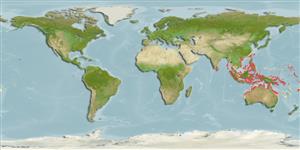>
Ovalentaria/misc (Various families in series Ovalentaria) >
Pomacentridae (Damselfishes) > Pomacentrinae
Etymology: Dischistodus: Greek, di = two + Greek, schistos = fissile stone, Plinius + Greek, odous = teeth (Ref. 45335).
More on author: Bleeker.
Environment: milieu / climate zone / depth range / distribution range
Οικολογία
Θαλασσινό(ά); Υφάλμυρο Υφαλόφιλο(α); μη μεταναστευτικό(ά); εύρος βάθους 1 - 12 m (Ref. 7247). Tropical; 26°N - 40°S
Indo-West Pacific: Nicobar Islands to Vanuatu, north to the Ryukyu Islands, south to northwest Australia and the Great Barrier Reef (Ref. 9710).
Μέγεθος / Βάρος / Age
Maturity: Lm ? range ? - ? cm
Max length : 18.5 cm TL αρσενικό/απροσδιόριστο; (Ref. 90102)
Ραχιαίες άκανθες (συνολικά): 13; Μαλακές ραχιαίες ακτίνες (συνολικά): 14-16; Εδρικές άκανθες 2; Μαλακές εδρικές ακτίνες: 14 - 15.
Adults inhabit lagoons and coastal reefs, usually in silty areas (Ref. 4966). The true D. prosopotaenia ranges from Singapore to Sulawesi while the yellow-breasted variant ranges from Irian Jaya to eastern Australia and Vanuatu (Ref. 48636). May be found solitary or in groups (Ref. 90102). Oviparous, distinct pairing during breeding (Ref. 205). Eggs are demersal and adhere to the substrate (Ref. 205). Males guard and aerate the eggs (Ref. 205). Diurnal species (Ref. 113699).
Life cycle and mating behavior
Γεννητική Ωρίμανση | Αναπαραγωγή | Γεννοβολία | Αβγά | Γονιμότητα | Προνύμφες
Oviparous, distinct pairing during breeding (Ref. 205). Eggs are demersal and adhere to the substrate (Ref. 205). Males guard and aerate the eggs (Ref. 205).
Allen, G.R., 1991. Damselfishes of the world. Mergus Publishers, Melle, Germany. 271 p. (Ref. 7247)
IUCN Red List Status (Ref. 130435)
Threat to humans
Harmless
Human uses
Περισσότερες πληροφορίες
ΑναφορέςΥδατοκαλλιέργειεςΠροφίλ υδατοκαλλιέργειαςΣτελέχοιΓενετικήElectrophoresesΚληρονομικότηταΑσθένειεςΜεταποίησηNutrientsMass conversion
Εργαλεία
Special reports
Download XML
Διαδικτυακές πηγές
Estimates based on models
Preferred temperature (Ref.
123201): 25.4 - 29.3, mean 28.6 °C (based on 2251 cells).
Phylogenetic diversity index (Ref.
82804): PD
50 = 0.5078 [Uniqueness, from 0.5 = low to 2.0 = high].
Bayesian length-weight: a=0.01479 (0.00642 - 0.03409), b=3.00 (2.80 - 3.20), in cm total length, based on LWR estimates for this (Sub)family-body shape (Ref.
93245).
Τροφικό Επίπεδο (Ref.
69278): 2.7 ±0.18 se; based on food items.
Ελαστικότητα (Ref.
120179): Μεσαίο(α), ελάχιστος χρόνος για διπλασιασμό πληθυσμού 1,4 - 4,4 έτη (Preliminary K or Fecundity.).
Fishing Vulnerability (Ref.
59153): Low vulnerability (10 of 100).
Nutrients (Ref.
124155): Calcium = 82.7 [45.2, 136.7] mg/100g; Iron = 0.689 [0.421, 1.073] mg/100g; Protein = 19 [18, 20] %; Omega3 = 0.135 [0.086, 0.212] g/100g; Selenium = 19.4 [11.5, 35.3] μg/100g; VitaminA = 109 [36, 318] μg/100g; Zinc = 2.12 [1.51, 2.91] mg/100g (wet weight);
